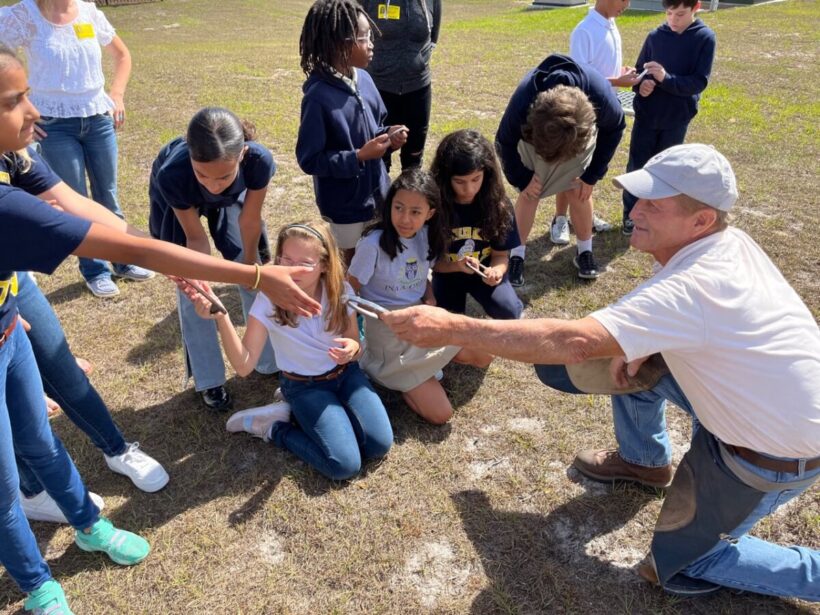Students learn about the equine industry through the Black Stallion Reading Project
The program, which provides books to thousands of local students, is a partnership of the Ocala Horse Alliance and Marion County Public Schools.

Dr. Jason Holloway, a veterinarian, goes over some instruments and medicines carried in his vehicle during a presentation at the Ina A. Colen Academy as part of the Black Stallion Reading Project organized by the Ocala Horse Alliance in partnership with Marion County Public Schools. [Andy Fillmore/Ocala Gazette]
The students in Karen Hayes’ fourth grade class at Ina A. Colen Academy in southwest Ocala were treated to a fun and educational show and tell session on April 21 by local horse industry professionals who help make this area the “Horse Capitol of the World.”
The session included presentations by a veterinarian, pioneering female jockey, blacksmith, horse nutrition professional and saddlery supplier as part of the Black Stallion Reading Project, a partnership between the nonprofit, all volunteer Ocala Horse Alliance and Marion County Public Schools (MCPS).
In early 2021, MCPS announced the first year of the five-year Black Stallion Reading Project and said the project would “harness horse power to encourage fourth grade students to read, set goals, achieve and become aware of job and career opportunities” in the horse industry.
According to PenguinRandomHouse.com, “The Black Stallion,” written by Walter Farley in 1941, is a “triumphant tale of a boy and a wild horse” who meet on a ship and are stranded on a desert island but are ultimately rescued.
The Black Stallion Reading Project includes a week of equine education, this year from April 24 to 28, for students at about 15 schools. It includes the distribution of 3,400 copies of the book “The Black Stallion” to fourth grade students in 32 local schools this year. In 2021, 3,100 students received a copy of the book and in 2022, 3,250 students got books.
The reading project is handled by volunteers and is fully funded by the Marion County horse industry, according to Ellie Trueman, president of the Ocala Horse Alliance.
The program on Friday began in a covered area in the center of the school, which is a tuition-free public charter school of choice located in the Calesa Township Community. It serves students in kindergarten through eighth grade.
Dr. Jason M. Holloway, a veterinarian with Superior Performance Equine Clinic, told the students about the educational requirements and day-to-day duties of a large animal vet, ranging from emergency situations to providing vaccinations, all to keep animal performance at a top level.
Holloway moved his presentation to the school’s parking area to show students his mobile set-up, which includes a medicine locker and X-ray and ultrasound equipment. He stressed the importance of keeping accurate records of animal care.
Holloway said he enjoys the outdoors and gets to work “with horses all day” while accompanied by his black Labrador retriever Luna.
“I love it,” he said.
Abby Fuller, a pioneering female jockey who raced mainly in the New England area from 1982 to 2012, spoke about her riding career. She said female professional jockeys first came on the scene in the 1970s. Fuller discussed the methods she used while racing a typically 800- to 1,200-pound horse, traveling up to 40 mph, which included proper use of the hands. She said one of the hardest things for jockeys is to maintain proper weight and that most weigh from 105 to 112 pounds. Fuller invited the students to try to assume a jockey’s posture and showed them how to handle imaginary reins.

Ina A. Colen Academy students Analisa Lapham, left, and Charlotte Price, strike a riding stance pose with pioneering female jockey Abby Fuller during a presentation on April 21, 2023. [Andy Fillmore/Ocala Gazette]
“Jockeys go out to the track around 5 a.m.,” for training she told the students.
Fuller showed a photo of her July 6, 1985, win in the Coaching Club American Oaks race with a $237,600 purse at Belmont Park in New York. She rode Mom’s Command and covered 1 ½ miles in 2:32. She wore green with gold crosses in the race. She also spoke about traveling to England in 1985 as part of a winning U.S. equestrian team. She also discussed the use of safety equipment including a helmet and Kevlar vest.
Miriam Gonzalez, area sales manager with Seminole Feed/Seminole Wellness, spoke of the importance of proper nutrition and the characteristics of baby horses. She also discussed the business aspect of the equine industry, including the expensive horses sold at Ocala Breeders’ Sales Company events.

Flash, a 15-year-old gelding, is introduced to students at Ina A. Colen Academy on April 21, 2023, during an educational session as part of the Black Stallion Project, a partnership between Marion County Public Schools and the Ocala Horse Alliance. [Andy Fillmore/Ocala Gazette]
Tom Wittman, blacksmith for the 1980 U.S. Olympic Equestrian Team, also called upon Flash to give the students a mock example of how a horse is shod and included a few tips about working around horses, learned from spending more than 65 years in the trade.

Blacksmith Tom Wittman shows horseshoes to Ina A. Colen Academy students during a Black Stallion Reading Project presentation on April 21 that showcased the equine industry. [Andy Fillmore/Ocala Gazette]
Athena Arevalo, 10, said being a jockey would be “fun” and you can get “the wind in your face.”
Hayes called the session a “valuable opportunity” for the students and said the students evidently were pleased as well.
“The students were saying this is one of the best days ever at school today,” she wrote in a text after the presentations.
For more information about the project, go to ocalahorsealliance.com/black-stallion-reading-project





